ATI Radeon X1900XTX CrossFire

Date: 24.01.2006
|
|
By:
Well, the even which has been a matter of most gossip in the Net for the past month has finally come true: ATI Technologies has officially introduced a new line of graphic processors Radeon X1900 and a number of solutions based on that.
Today, we are offering our readers the first material of the series of research of the capabilities of Radeon X1900 chips, and apart from the introductory theoretical part devoted mainly to the architectural and process improvements of the chip, we've got the chance to present the results of first tests for ATI Radeon X1900XTX CrossFire which were run at our test lab.
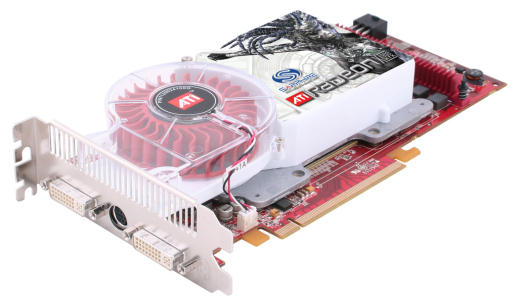
In the new graphics family ATI Radeon X1900 presented today there are three versions of chips - Radeon X1900XT, Radeon X1900XTX,and Radeon X1900XTX CrossFire Edition. The Radeon X1900XTX runs at the clock speed 650 MHz, offers 512 MB of GDDR3 memory at 1550 MHz. The specifications of Radeon X1900XT are a bit more moderate: the clock speed of the chip/memory - 625 MHz/1450 MHz (512 MB GDDR3). Finally, in the cards of the Radeon X1900 CrossFire Edition version, the chip runs at the clock speed 625 MHz, and the memory - at 1450 MHz. In the whole, we can state that the new chips offer clock speeds comparable to those for the X1800 series. In most cases, for Radeon X1900 XTX and X1900 XT they promised to use 1.1 ns GDDR3 memory by Samsung, although on the tested specimen of ATI Radeon X1900 CrossFire Edition Master card there was installed Samsung memory of 1.25 ns access time, which is equivalent to 1600 MHz DDR.
Apart from that, ATI is expected to present the "light" version of X1900XT named Radeon X1900XL with 256 MB or 512 MB memory. Evidently, this most inexpensive solution of the new flagship series is aimed at filling the vacuum that will definitely come up in the price niche $199-$499 after closing down the sales of Radeon X1800. Today, there seems to be no one who doubts that deliveries of Radeon X1800 will be closed down and follow the fate similar to NV30. Most likely, versions based on the mainstream core RV560 which, according to rumors, will acquire the marketing name Radeon X1700 and move to the same price range. For now, it is still rumors, but again the same rumors "promise" announcement of the Radeon X1700 series by the end of the first quarter of 2006, so not much time is left to wait. There are also assumptions and guesses that ATI will not deny itself the pleasure of complementing the multimedia series with Radeon X1900 All-In-Wonder video cards of the Radeon X1900XL class and GDDR3 memory of the clock speed 1.5 GHz (1.26 ns).
The engineering procedure used in the manufacture of Radeon X1900 series chips is the same as before – the 90-nm at the Taiwanese TSMC factories, however, the dimensions of the chip have gone up mainly due to the improvement of architecture and enlargement of various modules. Therefore, the overall number of transistors in the chip has now reached 384 mln. It is no wonder that the user's guide on operating Radeon X1900 series cards recommends to use a PSU of the nominal power no less than 450 W to provide a no less than 30A current in the 12V line. At the same time, to provide normal system operation on the base of the X1900XTX CrossFire Edition, a 550W PSU with the mandatory 38 A current and 12 V in the channel is a must.
Despite the changes in the architecture of Radeon X1900 chips, engineers at ATI have succeeded in attaining their electrical backward compatibility to the previous generation - Radeon X1800, due to which ATI's partners will be able to establish production of new cards quickly enough, without changes to the PCB design. What matters is that the graphic cards be in sufficient quantities. The management of ATI assures that the chip yield for R580 is substantially higher than the figures on the date of R520 announcement, so there won't be delays and deliveries of the novelties will start right today. We'll see if that is true in the nearest time, although you can follow this link: on the past Sunday already, samples of RADEON X1900 XTX and RADEON X1900 XT cards in the "proprietary" ATI package were seen at some retail shelves in Tokyo. They are also offering SAPPHIRE RADEON X1900 XTX PCI Express x16 (X1900XTX 512M PCI-E D-D/VIVO) video cards in the OEM-package, although at the unthinkable price ¥82900 (something about $720).
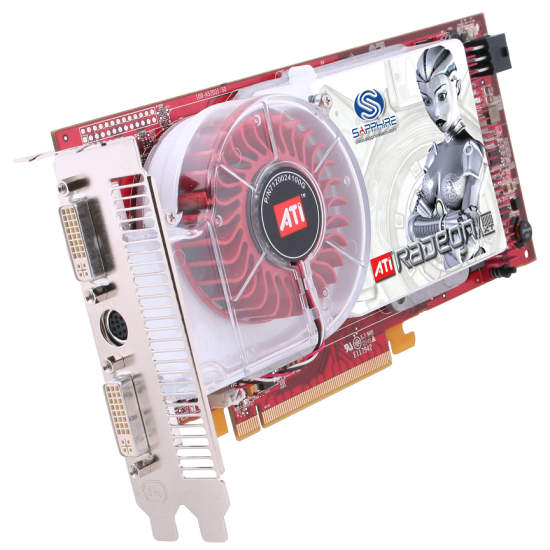
SAPPHIRE RADEON X1900 XT
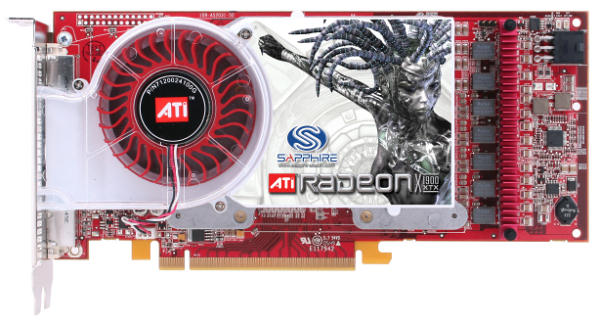
SAPPHIRE RADEON X1900 XTX
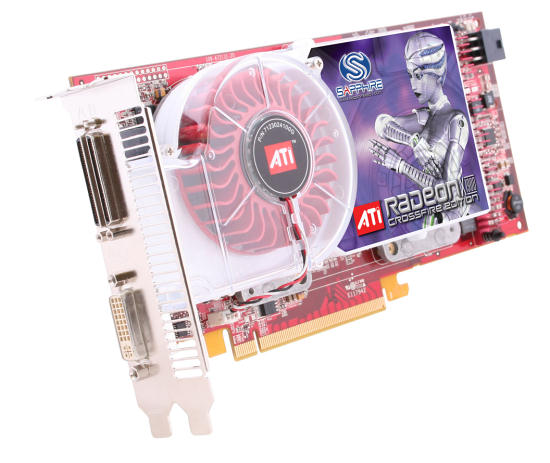
SAPPHIRE RADEON X1900 XTX CrossFire Edition
As regards the prices officially recommended by ATI, the version X1900 XTX has been estimated at $649, X1900XT - at $549, and X1900 XT CrossFire Edition – at $599.
Prior to moving to in-depth tests of the new graphic solution by ATI, let's sort out with the similarities and differences of the newly born Radeon X1900 series which formerly had the working name ATI R580 versus the predecessors – GPU of Radeon X1800 (R520) series. Especially confusing is the fact that Radeon X1800 chips were presented quite recently, in October - see our materials on this topic:
Let's look at the key specifications of Radeon X1900 series chips:
- Full-featured support for the PCI Express x16 bus
- Full support for Microsoft DirectX 9.0 Shader Model 3.0
- Eight vertex processors
-
Forty-eight pipelines for processing pixel shaders (pixel-shader processors). For comparison: 16 - in X1800 (R520), 8 - in X1600 (RV530), 4 - in X1300 (RV515)
- Sixteen texture mapping units
- 256 MB or 512 MB (up to 1 GB) of 8-channel graphic GDDR3 memory (with the outlook of support for GDDR4).
- Internal 512-bit circular memory bus, 256-bit interface (8 chips of 512-bit GDDR3 memory are used); programmable arbitration logic, new design of associative texture-mapping, color and Z/stencil caches, hierarchical Z-buffer, Z-compression with no-loss compression (up to 48:1), fast clearing of Z-buffer
- Performance optimization for high-resolution displays, including HDTV-displays
- Decoding of all DTV/HDTV formats
- SmoothVision technology
- AA - 2x/4x/6x modes, with no-loss compression at up to 6:1 ratio in all resolutions
- Anisotropic Filtering modes - 2x/4x/8x/16x
- Adaptive pixel-wise rendering
- Ultra-Threaded Shader Engine - multithreaded data processing, up to 512 pixel threads concurrently, full-speed 128-bit FPU computations
- Improved thread prediction and branching mechanism
- Up to 1536 instructions per cycle
- Support for high-resolution texture processing (up to 4k x 4k)
- Texture compression at с 64-bit FPU precision, including 3Dc+
- High-quality 4:1 compression for normal and luminance mapping.
- Support for OpenGL 2.0
- High Dynamic Range (HDR) rendering
Therefore, the major advantage of the new series of Radeon X1900 graphic chips in the unheard of number of pixel-shader processors whose number has been increased to forty-eight, which allows using the capabilities of DirectX 9 API and Shader Model 3.0 to the full. The process technology used in the manufacture of Radeon X1900 has remained the same – 90 nm, and the number of transistors as compared to Radeon X1800 has gone up by almost 20%. The other key novelties were first introduced in the Radeon X1800 series, including Ultra-Threading, HDR with AA, Avivo etc.
In order to give a visual idea of the complication in the pixel-shader processing module architecture in Radeon X1900, let me bring in a couple of slides, with the upper one showing the pixel-shader engine X1800 and the bottom one - for X1900.
In practice, the organization of the shader engine X1900 has remained the same - 48 pixel processors are arranged into groups of four cores (ATI's Quad-pixel Shader Core), plus an array of general-purpose registers, 16 blocks of texture-mapping addressation and the distributing Ultra-Threading processor. The only difference is in that X1800 had 16 pixel processors.
Every pixel-shader processor of the Radeon X1900 chip is able executing within 1 to 5 shader instructions per cycle in various ALU. The dedicated module for branching analysis is designed to control of the usage of instruction threads. Every texture module and the texture-mapping addressation unit whose usage is controlled by the distributing Ultra-Threaded Dispatch Processor is able processing up to four textures samples per cycle.
The architecture of fully associative cache used in Radeon X1900 is a complete replica of the features implemented in Radeon X1800 that provide sampling textures from any part of external memory, which is more efficient than formerly used Direct Mapped and N-Way architectures of the associative cache. The textured, colored, Z and Stencil caches also offer a fully associative structure.
To facilitate the process of dynamic branching and increase performance of the shade rendering technology, Radeon X1900 chips use a new feature for texture-mapping sampling called Fetch4. The idea behind Fetch4 is in the use of the principle implying that textures are essentially sets of information on the color data of a point, each comprising four components - Red, Green, Blue, and transparent (Alpha). Therefore, the texture units are designed for a simultaneous modeling and filtering of all the four components of the texture address. Therefore, due to the technology of fast control of Ultra-Threading data flow and the Fetch4 the Radeon X1900 chips are able providing a faster display of soft shades than the conventional technology of shade mapping.
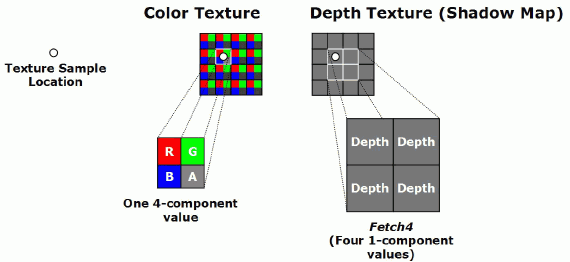
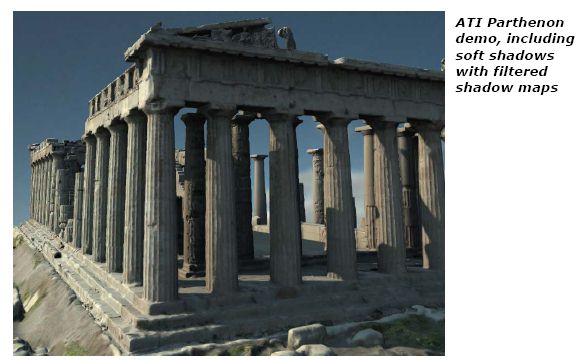
Finally, the painful issue for many is the support for high resolutions in games. The Radeon X1900 chip offers a 50% greater memory capacity for Hierarchical Z than its predecessor Radeon X1800, which will help maintain high performance at high resolutions of the screen. Judging by the specifications, Radeon X1900 chips will easily cope with support for 1920 x 1200 (WUXGA), 2048 x 1536 (QXGA) resolutions, up to 2560x1600 (WQXGA).
Therefore: 48 pixel-shader processors, the Fetch4 technology, and improved technique for handling Hierarchical Z at high resolutions of the screen – these are the major novelties implemented in Radeon X1900 series chips. For details of legacy features inherited by Radeon X1900 from its predecessors of X1000 series, I am referring the inquisitive reader to the background information on the subject - X1000 - ATI's new-generation graphics.
On the next page, you will see how successful the Radeon X1900 chip has proved and what can be squeezed out of it.
Next 
 |
Content: |
 |
|
 |
Top Stories: |
 |
 |
 |
MoBo:


|
 |
 |
 |
VGA Card:


|
 |
 |
 |
CPU & Memory:

|
|
|
